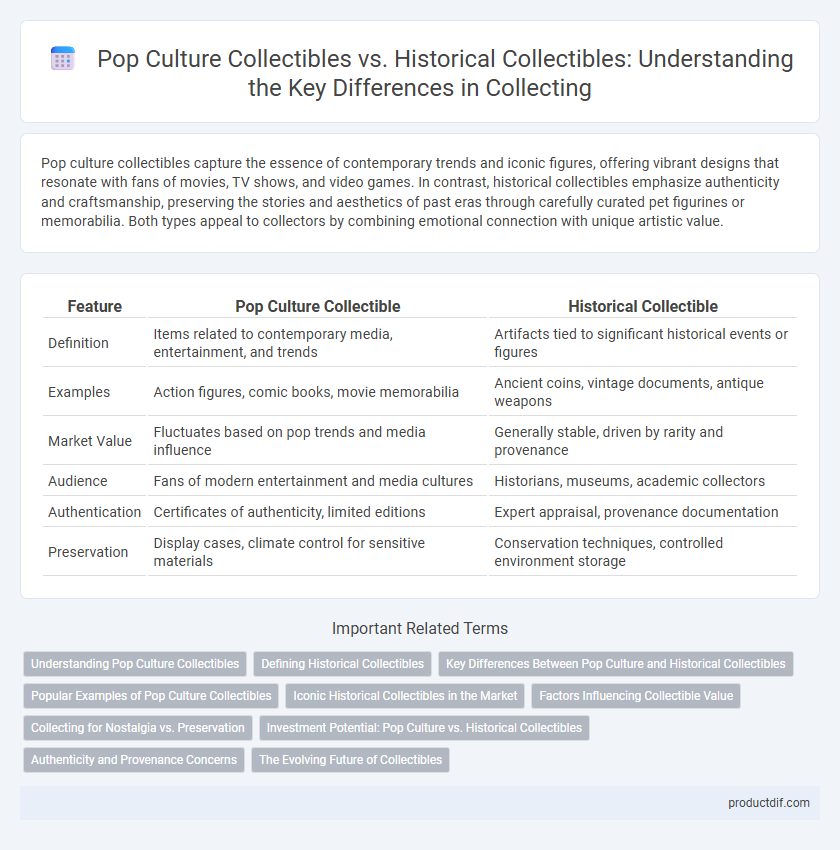Pop culture collectibles capture the essence of contemporary trends and iconic figures, offering vibrant designs that resonate with fans of movies, TV shows, and video games. In contrast, historical collectibles emphasize authenticity and craftsmanship, preserving the stories and aesthetics of past eras through carefully curated pet figurines or memorabilia. Both types appeal to collectors by combining emotional connection with unique artistic value.
Table of Comparison
| Feature | Pop Culture Collectible | Historical Collectible |
|---|---|---|
| Definition | Items related to contemporary media, entertainment, and trends | Artifacts tied to significant historical events or figures |
| Examples | Action figures, comic books, movie memorabilia | Ancient coins, vintage documents, antique weapons |
| Market Value | Fluctuates based on pop trends and media influence | Generally stable, driven by rarity and provenance |
| Audience | Fans of modern entertainment and media cultures | Historians, museums, academic collectors |
| Authentication | Certificates of authenticity, limited editions | Expert appraisal, provenance documentation |
| Preservation | Display cases, climate control for sensitive materials | Conservation techniques, controlled environment storage |
Understanding Pop Culture Collectibles
Pop culture collectibles represent items tied to contemporary media, entertainment franchises, and iconic figures from movies, television, music, and video games, making them highly desirable for fans and collectors worldwide. These collectibles often carry nostalgia value and limited edition releases, driving market demand and price appreciation. Understanding the significance of characters like Marvel superheroes or Star Wars memorabilia highlights the emotional and cultural connection that differentiates pop culture collectibles from historical artifacts.
Defining Historical Collectibles
Historical collectibles represent artifacts and memorabilia directly connected to significant events, periods, or figures from the past, such as ancient coins, Civil War relics, or vintage propaganda posters. These items hold intrinsic cultural and historical value, often providing tangible insights into specific moments in history or societal developments. Unlike pop culture collectibles, which derive worth from entertainment and media trends, historical collectibles gain their significance from their documented provenance and enduring impact on heritage.
Key Differences Between Pop Culture and Historical Collectibles
Pop culture collectibles primarily focus on items related to movies, TV shows, comics, and music, often reflecting contemporary trends and fan interests, while historical collectibles center on artifacts with significant past events or cultural heritage. Pop culture items tend to have high demand driven by fandom and nostalgia, whereas historical collectibles are valued for their rarity, provenance, and educational significance. Market pricing and authenticity verification differ substantially, with pop culture collectibles frequently relying on limited editions and autographs, and historical collectibles requiring thorough documentation and preservation status.
Popular Examples of Pop Culture Collectibles
Pop culture collectibles include iconic items like Funko Pop figures, Star Wars memorabilia, and limited-edition comic books, highlighting their strong ties to contemporary media and entertainment. These collectibles often gain value through character popularity, franchise longevity, and fan engagement, contrasting with historical collectibles, which are valued for their rarity, age, and historical significance. The mass production and vibrant fanbase of pop culture collectibles create dynamic markets fueled by nostalgia and current trends.
Iconic Historical Collectibles in the Market
Iconic historical collectibles hold significant market value due to their rarity and cultural importance, often representing pivotal moments or figures in history. Items such as vintage documents, artifacts from notable events, and memorabilia associated with influential personalities attract dedicated collectors and investors. These collectibles not only preserve heritage but also appreciate over time, contrasting with pop culture collectibles, which typically reflect modern entertainment trends and may fluctuate in demand based on current popularity.
Factors Influencing Collectible Value
Pop culture collectibles derive value from factors such as rarity, condition, and cultural relevance tied to iconic movies, music, or celebrities, often driven by current trends and fan demand. Historical collectibles gain value through provenance, age, and significance in historical events or periods, appealing to collectors interested in preserving heritage and authenticity. Market scarcity and the item's story both play crucial roles in determining the long-term investment potential of these collectibles.
Collecting for Nostalgia vs. Preservation
Pop culture collectibles evoke nostalgia by capturing moments from movies, music, and television that define specific eras, making them highly sought after for personal sentimental value. Historical collectibles prioritize preservation, focusing on artifacts that document and protect cultural heritage, often valued for their educational and historical significance. Collectors driven by nostalgia seek emotional connections, while those interested in preservation emphasize authenticity and long-term conservation of historical context.
Investment Potential: Pop Culture vs. Historical Collectibles
Pop culture collectibles, such as limited-edition action figures or signed memorabilia, often experience rapid value spikes driven by trends and fan enthusiasm, but they can be volatile over time. Historical collectibles, including ancient artifacts or vintage documents, tend to hold intrinsic value due to their rarity and cultural significance, offering more stable long-term investment potential. Market demand, provenance, and authenticity play critical roles in determining the investment returns of both pop culture and historical collectibles.
Authenticity and Provenance Concerns
Pop culture collectibles often face challenges in verifying authenticity due to mass production and widespread replication, making provenance documentation crucial for distinguishing genuine items from fakes. Historical collectibles demand rigorous provenance research to confirm origin and historical significance, as their value hinges on verified authenticity and traceable ownership. Both categories require expert evaluation and proof of legitimacy to ensure collectors invest in authentic and valuable pieces.
The Evolving Future of Collectibles
Pop culture collectibles such as action figures, limited edition sneakers, and movie memorabilia increasingly leverage digital platforms and blockchain technology for authentication and trading, driving a dynamic market evolution. Historical collectibles, including ancient coins, rare manuscripts, and vintage artifacts, maintain steady demand through traditional auction houses adapting to online sales and enhanced provenance verification methods. The evolving future of collectibles blends physical rarity with digital innovation, expanding global accessibility and transforming how collectors value and preserve cultural significance.
Pop Culture Collectible vs Historical Collectible Infographic

 productdif.com
productdif.com